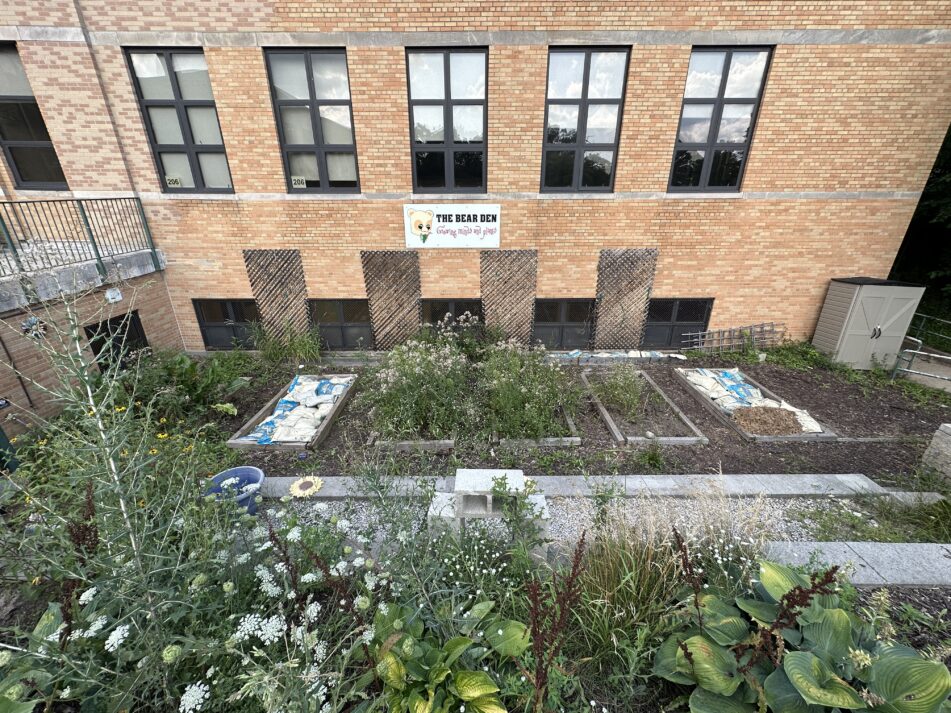Carolyn Herrmann steps down as one of the district’s most active volunteer gardening coordinators; says the many years of service have been well worth it


Carolyn Herrmann says it’s bittersweet to be stepping away after 11 years as a volunteer garden coordinator for AAPS.
After all, she was a big part of getting gardens started or expanded at King, Dicken, Slauson and Community, and has served on the AAPS Farm-to-School Collaborative.
But she’s happy she’s knowing that her final project was to change the name and rebranding of the garden she helped create four years ago with a lot of help from CHS students and other volunteers.
The newly named Jones Community Garden at Community High School honors the roots of the school building. The rebranded Jones Community Garden was unveiled this spring in coordination with the ongoing efforts to celebrate the history of Jones School and the building, and now is flourishing.
Named in honor of Jones School—the neighborhood school that was open from 1923 to 1965 and served Ann Arbor’s historically Black neighborhood now known as Kerrytown.
Community High School opened in the building in 1972. CHS staff and students honored the history of the school in many ways this past year, and the garden was officially changed to “Jones Community Garden” in the spring.
Katia Angelova, the parent of an incoming CHS senior, has volunteered on three school gardens with Herrmann and says Herrmann inspired her every step of the way.
“My major motive for being a garden volunteer for so long is just because I had the chance to work with Carolyn,” she said. “She always wants to make everything so perfect and looking nice, so it’s been a pleasure working with her and supporting her.”
Community French teacher Danelle Mosher recalls talking with Herrmann and student Julia Sonen about the possibility of a garden back in 2019 and taking it to her forum, who responded eagerly.
Her forum classroom looks out onto the garden, and Mosher says it’s nice for the students to step outside to get sunshine and fresh air and to help out when they can.
She said the collaboration process is something that Community High School strives for.
“So it’s exciting when it’s something so beautiful as this garden and we end up with a project like this,” she said.
Herrmann’s volunteer gardening in the district began in 2012 at King Elementary. Former King teacher Neha Shah, who was passionate about starting a garden there, heard that Herrmann was interested in health and nutrition.
“I liked the idea of a garden,” says Herrmann. “Didn’t know much about it. Didn’t know much about growing anything. I said, `If you do that, I’m on board.'”
So began the King Learning Garden, and here is what it looks like today:

Then in 2013, Herrmann’s family moved to the Dicken area, and she and another parent spearheaded the task of turning the small fledgling garden into the lush 5,000-foot garden it is today.

Then when her oldest of two children enrolled in her alma mater, Slauson Middle School, she helped improve the existing garden, encourage more student and teacher involvement, and create an outdoor classroom there.

After that, she became a Community High parent when both of her children became students, with her younger child, Sid, having just graduated.
Herrmann says she appreciates all the volunteers, working with teachers to engage students in the garden, as well as the financial contributions of Ann Arbor Farm & Garden, the PTO and parents at each school, Whole Kids Foundation, and IBM, as well as discounts and donations of garden essentials from places such as Downtown Home & Garden, Fendt Builder’s Supply, Green Things Farm Collective, Lowes, and Home Depot.
Was all the hard work over 11 years worth it?
Absolutely, says Herrmann, a 1987 graduate of Pioneer High School.
“It allowed me to volunteer at my kids’ school in a way that felt good to me,” says Herrmann, who is also appreciative of the support shown by the administration. “And I feel like the things that I did had a really positive impact. At least in my mind, I helped create something new and better for these schools that also allowed for different kinds of programming. The gardens offered an exciting way for students to engage in learning that complemented what was being taught in the classroom and added tremendous beautification of the school properties. So absolutely, I think it was worth it.”

Be the first to comment